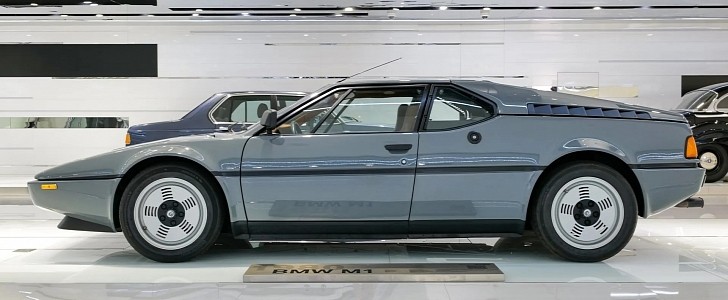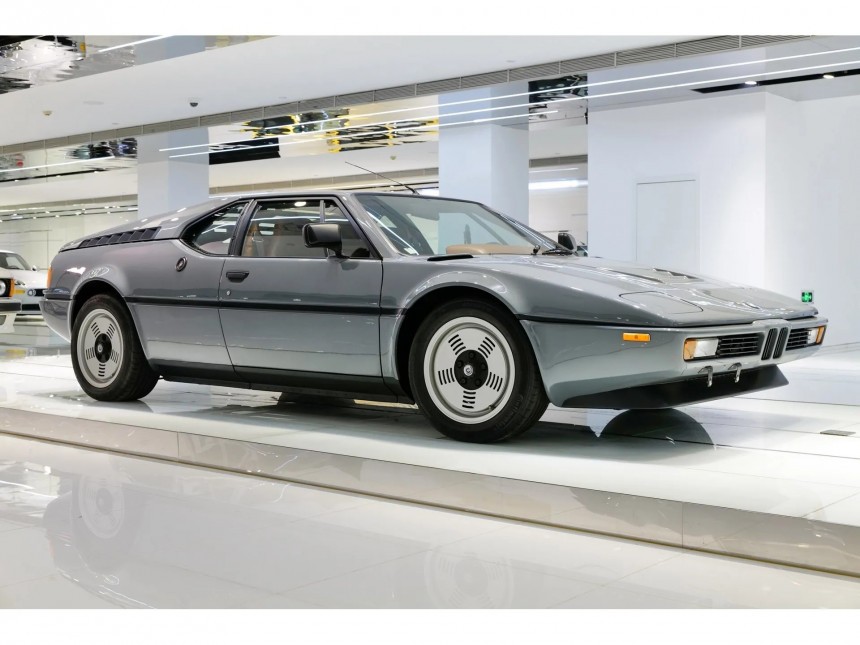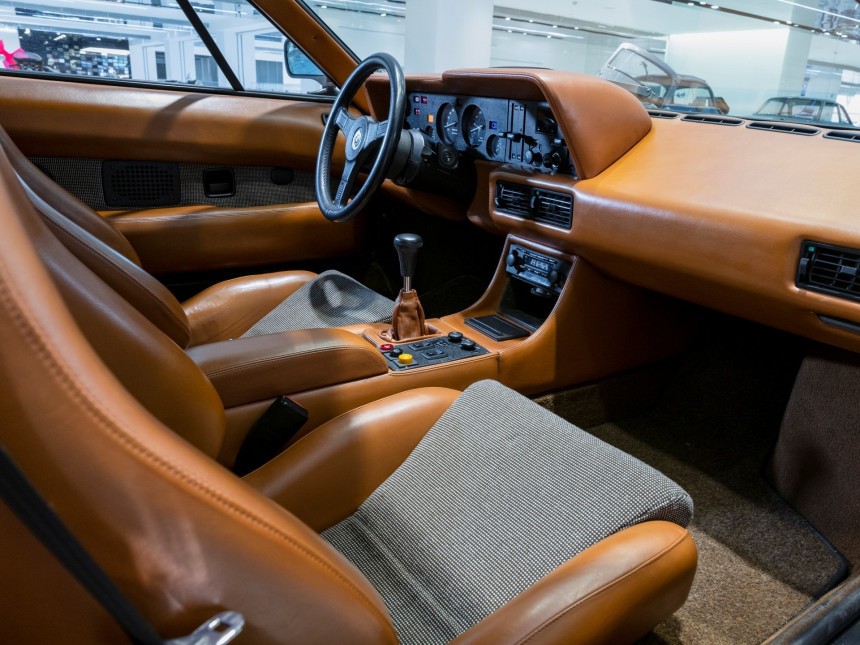Wedge car design brought about some remarkable automobiles, steering clear from the rounded shapes and fluid profiles of the sixties and plunging into the aggressive, menacing straight radii and sharp angles of the 70s and 80s. Out of the beautiful cars of that decade, one unique BMW M1 tells a nostalgic story.
One particular Italian design office had a crucial role in promoting the blade-like car designs of the era – Italdesign of Giorgio Giugiaro, who put some memorable cars on the roads. Remember the all-too-futuristic DeLorean or the fiery VW Porsche Tapiro prototype. And, of course, the BMW M1 – the first supercar of the Bavarians and, coincidentally, the first car developed solely by the M division of the German company. Also, the only car ever built by Italdesign.
What that means is that they didn’t take a regular production BMW and put the M badge and engineering on the car but started from the ground up. Spurred by their co-nationals and bitter rivals of Porsche (for once, Mercedes wasn’t part of a Teutonic automotive feud), who were winning big in motor racing, BMW sought to produce a car able to rise to the challenge.
Naturally, they turned to their motorsport division, and so Jochen Neerpasch (then head of the division) got the task to make a new car. A racer, something to take on the 911s of Porsche and beat them at their game. There was, however, one major obstacle: to meet the motorsport governing body’s regulations, 400 automobiles had to be built in a specific timeframe.
Amazingly, BMW lacked the logistics to meet that requirement, so it asked Lamborghini for help. The choice was not arbitrary – back in the late 70s, the Italian brand had a strong reputation for its mid-engined know-how. However, for various reasons, the agreement went bust, and the Germans were left with a choice: do it themselves or scrap everything altogether.
Fortunately, they didn’t lose hope and carried on. With a Giugiaro design in hand, an in-house engine available, and a goal to meet, BMW pulled itself together and gave the motoring world a masterpiece. Built in just 455 examples between 1978 and 1981, the M1 is among the rarest BMWs, and collectors are always on the lookout for one.
As it so happens, one such rarity is now offered at an auction in Munich a month from now. But this M1 is extra-special – it was the car that Jochen Neerpasch ordered for himself. The head of BMW Motorsport has owned this very car since it rolled off the assembly line. A one-of-four gray M1s, it is the only one with a brown interior.
The fiberglass body over the tubular steel space-frame chassis kept the weight down – a necessity for racing, a time-saving convenience for the production line, and a spectacular car for the road. The 3.5-liter straight-six had a power output of 273 bhp (277 PS) at 6,500 rpm and 243 lb-ft (330 Nm) of torque at 5,000 rpm.
That was the street-legal version. The race model would trigger 460 bhp (470 PS) – probably one such version was tested by Giugiaro himself and hit 174 mph (280 kph) – watch the designer tell the story of M1 in the video below. Otherwise, the civilian M1 could “only” achieve 165 mph (265 kph). A five-speed manual transmission put the power to the rear wheels, and disc brakes took care of that engine force. No power steering, but air conditioning, a stereo, and power windows drew attention away from the non-adjustable seats (covered in a mixture of leather and cloth).
The Neerpasch car auctioned next month is one of the best-treated classic cars – in 2013 it won an award at Concorso d’Eleganza Villa d’Este: Trofeo ASI for “the best-preserved post-war car.” The original owner sold the car after a decade of use – during which the M1 gathered around some 15,000 miles (24,000 kilometers) on the odometer. “And this was one of my mistakes in life,” admitted Jochen Neerpasch to RM Sotheby’s earlier his month.
The next driver who enjoyed this unique M1 put new paint on the automobile and then sold it. After the 2013 achievement, the M1 changed hands two more times and then retired to a private collection. One reason for its next owner is to have the special BMW M1 minutely inspected in every mechanical detail before putting it on the road.
What that means is that they didn’t take a regular production BMW and put the M badge and engineering on the car but started from the ground up. Spurred by their co-nationals and bitter rivals of Porsche (for once, Mercedes wasn’t part of a Teutonic automotive feud), who were winning big in motor racing, BMW sought to produce a car able to rise to the challenge.
Naturally, they turned to their motorsport division, and so Jochen Neerpasch (then head of the division) got the task to make a new car. A racer, something to take on the 911s of Porsche and beat them at their game. There was, however, one major obstacle: to meet the motorsport governing body’s regulations, 400 automobiles had to be built in a specific timeframe.
Amazingly, BMW lacked the logistics to meet that requirement, so it asked Lamborghini for help. The choice was not arbitrary – back in the late 70s, the Italian brand had a strong reputation for its mid-engined know-how. However, for various reasons, the agreement went bust, and the Germans were left with a choice: do it themselves or scrap everything altogether.
Fortunately, they didn’t lose hope and carried on. With a Giugiaro design in hand, an in-house engine available, and a goal to meet, BMW pulled itself together and gave the motoring world a masterpiece. Built in just 455 examples between 1978 and 1981, the M1 is among the rarest BMWs, and collectors are always on the lookout for one.
As it so happens, one such rarity is now offered at an auction in Munich a month from now. But this M1 is extra-special – it was the car that Jochen Neerpasch ordered for himself. The head of BMW Motorsport has owned this very car since it rolled off the assembly line. A one-of-four gray M1s, it is the only one with a brown interior.
The fiberglass body over the tubular steel space-frame chassis kept the weight down – a necessity for racing, a time-saving convenience for the production line, and a spectacular car for the road. The 3.5-liter straight-six had a power output of 273 bhp (277 PS) at 6,500 rpm and 243 lb-ft (330 Nm) of torque at 5,000 rpm.
That was the street-legal version. The race model would trigger 460 bhp (470 PS) – probably one such version was tested by Giugiaro himself and hit 174 mph (280 kph) – watch the designer tell the story of M1 in the video below. Otherwise, the civilian M1 could “only” achieve 165 mph (265 kph). A five-speed manual transmission put the power to the rear wheels, and disc brakes took care of that engine force. No power steering, but air conditioning, a stereo, and power windows drew attention away from the non-adjustable seats (covered in a mixture of leather and cloth).
The Neerpasch car auctioned next month is one of the best-treated classic cars – in 2013 it won an award at Concorso d’Eleganza Villa d’Este: Trofeo ASI for “the best-preserved post-war car.” The original owner sold the car after a decade of use – during which the M1 gathered around some 15,000 miles (24,000 kilometers) on the odometer. “And this was one of my mistakes in life,” admitted Jochen Neerpasch to RM Sotheby’s earlier his month.
The next driver who enjoyed this unique M1 put new paint on the automobile and then sold it. After the 2013 achievement, the M1 changed hands two more times and then retired to a private collection. One reason for its next owner is to have the special BMW M1 minutely inspected in every mechanical detail before putting it on the road.




















































